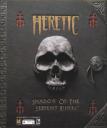Lost Classics: The Serpent Riders Trilogy (PC, Playstation, N64, Saturn)
by William Talley, filed in Games, Lost Classics on Sep.29, 2007
 ID software, the fathers of the first person shooter, had three major franchises in the genre; Wolfenstein 3-d, Doom, and Quake. There was also a fourth series that, while it wasn’t was well known as the other three, managed to provide some unique twists on the FPS genre all on its own. Even though it was developed by Raven Software, it maintained the innovation that had been present in ID’s other franchises. The Serpent Riders Trilogy, better known as Heretic, Hexen, and Hexen 2, followed the player’s quest the save the world from three ancient demons. While most shooters of the time placed players in a science fiction setting, Heretic and its sequels placed gamers in a fantasy realm. This was a first at the time, and it was an experience which few FPS games have managed to replicate. Even today, you’ll be hard pressed to find a first person shooter game willing to deviate from the norm this drastically.
ID software, the fathers of the first person shooter, had three major franchises in the genre; Wolfenstein 3-d, Doom, and Quake. There was also a fourth series that, while it wasn’t was well known as the other three, managed to provide some unique twists on the FPS genre all on its own. Even though it was developed by Raven Software, it maintained the innovation that had been present in ID’s other franchises. The Serpent Riders Trilogy, better known as Heretic, Hexen, and Hexen 2, followed the player’s quest the save the world from three ancient demons. While most shooters of the time placed players in a science fiction setting, Heretic and its sequels placed gamers in a fantasy realm. This was a first at the time, and it was an experience which few FPS games have managed to replicate. Even today, you’ll be hard pressed to find a first person shooter game willing to deviate from the norm this drastically.
Heretic and Hexen, the first two games in the series, were built using slightly modified versions of the Doom engine. In fact, many of the level builders and source ports used by Doom modders were cross-compatible with Heretic and Hexen. There were even Doom WADS that could be played in Heretic and vice-versa. However, the games made a few key changes. Heretic was among the first FPS titles that alowed players the ability to look up or down. Hexen even allowed jumping, and supported network play for up to 8 players. The games also featured inventory management, and a HUB-level system, similar to games such as Metroid. Hexen allowed the player to choose one of three character classes at the start of the game: Fighter, Cleric, and Mage. Each of them had a different set of weapons, abilities, strengths, and weaknesses. Hexen 2, built using a modified Quake engine, further expanded on the formula. The action took place on 5 continents, each with their own theme and setting. This time, players could choose to be a Necromancer, Paladin, Assassin, or a Cleric. The HUB levels were interconnected, with changes in one area affecting another. The game featured destructible environments and mounted weaponry. The RPG elements were expanded upon further with a leveling-up system.
As in typical ID fashion, there were a few expansion packs released for the games. Heretic however, was released only as three unlinked episodes, and a later-released retail version contained the first three as well as two new episodes. Hexen received Deathkings of the Dark Citadel, which added three new episodes. Hexen 2’s expansion, Portals of Praevus, added a new continent, new enemies, new levels, and a new character class (The Demoness). The closest thing the series would receive to a follow up would be 1999’2 Heretic 2. Even though it was built on a modified version of the Quake 2 engine, the game was a third person shooter rather than an FPS game, causing controversy among fans. Its a shame too, as this series has yet to receive a remake/follow up along the lines of Doom 3 and Return to Castle Wolfenstein. However, Raven has released the source code to the first three games, making it available for MAC OS and Linux. Moreover, Heretic, Hexen, and Hexen 2, and their expansion packs are available on the Steam distribution network, along with ID software’s entire back catalog. Also, there are still plenty of mods and custom WAD files for the three games available on various sites on the web. Weather you’re a fan of ID Software, or just FPS games in general, you would do well to check out this series. If nothing else, it does something different for the genre.


 PS3
PS3
 Famicom Dojo
Famicom Dojo KEEP PLAYING
KEEP PLAYING KEEP PLAYING: Rewind
KEEP PLAYING: Rewind Powet Toys
Powet Toys Powetcast
Powetcast Hitchhiker's Guide POWETcast
Hitchhiker's Guide POWETcast














